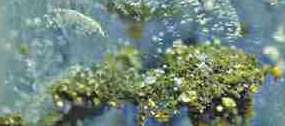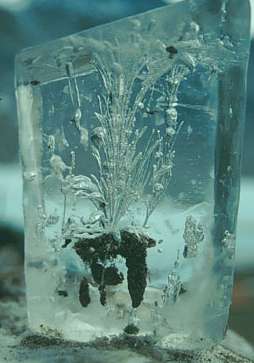Two world-views are more and more colliding in respect to the conditions in which life can exist. The collisions become acute and results in harsh controversies when the topic is whether life can exist on Mars or not.
One party strongly advocates that the conditions on Mars make it either impossible or improbable that life can exist there, either at any Martian place or just on the surface.
This article has a limited goal. The goal is to offer one part of an inventory of the most extreme conditions in which life exists on Earth. This serves as argument for the notion that the "habitable zone" for terrestrial life has been recently found to be much broader than previously thought.
The part of that inventory discussed here is: the cold environment.
Common belief of laymen has it that at 0°C or below, life cannot keep its metabolism because water freeze.
Common belief of laymen also has it that in a block of ice, the temperature is homogeneously below 0°C and thus life cannot exist in it.
The fact that bacteria are found locked in ice or ancient ice was in the mass media as soon as 1998. However, these announcements generally referred to bacteria that were dormant and eventually sometimes revived, not to live that was thriving. [1]
But as of 1998, Crypotendolithotrophs bacteria were also known to be thriving in Antarctica at -15°C. [2] [3]
It is generally accepted that living cells react slowly if temperatures are too cold and stop reacting around -15°C. However, this does not mean at all that life is killed at -15°C.
One record breaking discovery was when in January 1999 and 2000, large populations of 200 to 5,000 ml of bacteria cells were discovered in surface snow at the southern polar cap. DNA isolated from the sample snow revealed DNA sequences similar to those of several psychrophilic bacteria, and, interestingly, a bacterium close to the Deinococcus genus, about which more will be said elsewhere. [7]
The conditions on Mars regarding cold it that the extreme cold is well below -15°C. However, the cold is not constant everywhere and always on Mars, not even on the ordinary surface, and when excluding Mars from the habitable zone by citing the extreme low temperatures that occur on Mars, a mistake is made in the sense that another type of resistance of life is ignored: dormancy. Dormancy will be discussed further in a separate article.
Another mistake is done when a cold temperature is seen as an absolutely even condition. It was on the contrary discovered in 1998 that colonies of bacteria were not only dormant but living and thriving in the ice-covered lakes in the McMurdo Dry Valleys of Antarctica (76°30-78°20S, 160°-164°E). [3]. Although the temperature there would be measured both in the air or in the ice as of well below -15°C and the dryness of the landscape appears total with absolutely no liquid water, buried lakes but also microscopic water pockets embedded two meters deep in solid ice held these colonies of bacteria.
Previously, the permanent ice covers of our polar regions were indeed considered as physical barriers to wind mixing, material transport, and solar radiation necessary for photosynthesis. It is only recently that it was recognized that these regions do support viable microbial habitats and populations.
The realization came from several steps of discoveries: First, anomalous nitrous oxide gas was measured in the ice cover. Then, microalgal and bacterial cells were found in tight association with resident sediment inclusions within the interior of several permanent ice covers. Then historical temperature records were analyzed and found to indicate that substantial amounts of liquid water, up to 70% by ice volume, were generated in the regions where sediment inclusions existed in the ice during the summer months. The temperature records and the bubble morphologies around such inclusions resulted in the understanding that the absorption of penetrating radiation by the inclusions, in the absence of conductive processes which could dissipate the resultant heat energy led to localized ice melting and refreezing of generated liquid water pockets. And finally it was observed that the organisms around these inclusions were not inert but alive and thriving.

|
Colony of bacteria thriving in a bloc of ice from the Antarctic. |
These findings were published in scientific peer reviewed journals, such as a 1998 paper in Science magazine with the following statements in its abstract:
"The permanent ice covers of Antarctic lakes in the McMurdo Dry Valleys develop liquid water inclusions in response to solar heating of internal aeolian-derived sediments. The ice sediment particles serve as nutrient (inorganic and organic)-enriched microzones for the establishment of a physiologically and ecologically complex microbial consortium capable of contemporaneous photosynthesis, nitrogen fixation, and decomposition. The consortium is capable of physically and chemically establishing and modifying a relatively nutrient and organic matter-enriched microbial "oasis" embedded in the lake ice cover." [3]
Previously totally unknown, the thriving bacteria colonies in ice were found by a team of experts led by Stephen Giovannoni, associate professor of microbiology at America's Oregon State University, who said:
"This is a very barren environment with virtually nothing we usually associate with living organisms. But these photosynthetic cyanobacteria are alive, self-sufficient and growing. They have their own little world there we knew nothing about." [1]
He also said:
"It's been suggested that Mars is too dry and cold for life to exist. But it's also known that both Mars and Europa have frozen water on or near their surfaces. We speculate that similar life forms could exist on Mars or Europa." [2]
Another study of discovered bacterial life beneath a high arctic glacier commented that such a "terrestrial environment may provide a model for viable habitats for life on Mars, since similar conditions may exist or may have existed in the basal sediments beneath the Martian north polar ice cap." [8]
Another research on Antarctic ice pushed the lowest temperature for life on Earth limit down to -20°C, indicating:
"CTC-active bacteria (0.5 to 4% of the total) and cells detectable by rRNA probes (18 to 86% of the total) were found in all ice samples, including the coldest (-20°C), where virtually all active cells were particle associated. The percentage of active bacteria associated with particles increased with decreasing temperature, as did the percentages of CFB (16 to 82% of Bacteria) and Archaea (0.0 to 3.4% of total cells). These results, combined with correlation analyses between bacterial variables and measures of particulate matter in the ice as well as the increase in CFB at lower temperatures, confirm the importance of particle or surface association to bacterial activity at subzero temperatures. Measuring activity down to -20°C adds to the concept that liquid inclusions in frozen environments provide an adequate habitat for active microbial populations on Earth and possibly elsewhere." [9]
Other science teams reported similar findings. [4] [5] [6] [10] [11]

|
Colony of bacteria thriving in a bloc of ice from the Antarctic. Non-ice material heats at the sun's rays and heat dissipation creates pocket of liquid water and bubbles. The non ice-material serves as food to the bacteria. It results in a thriving ecosystem although the general temperature of the ice is well below 0°C. |